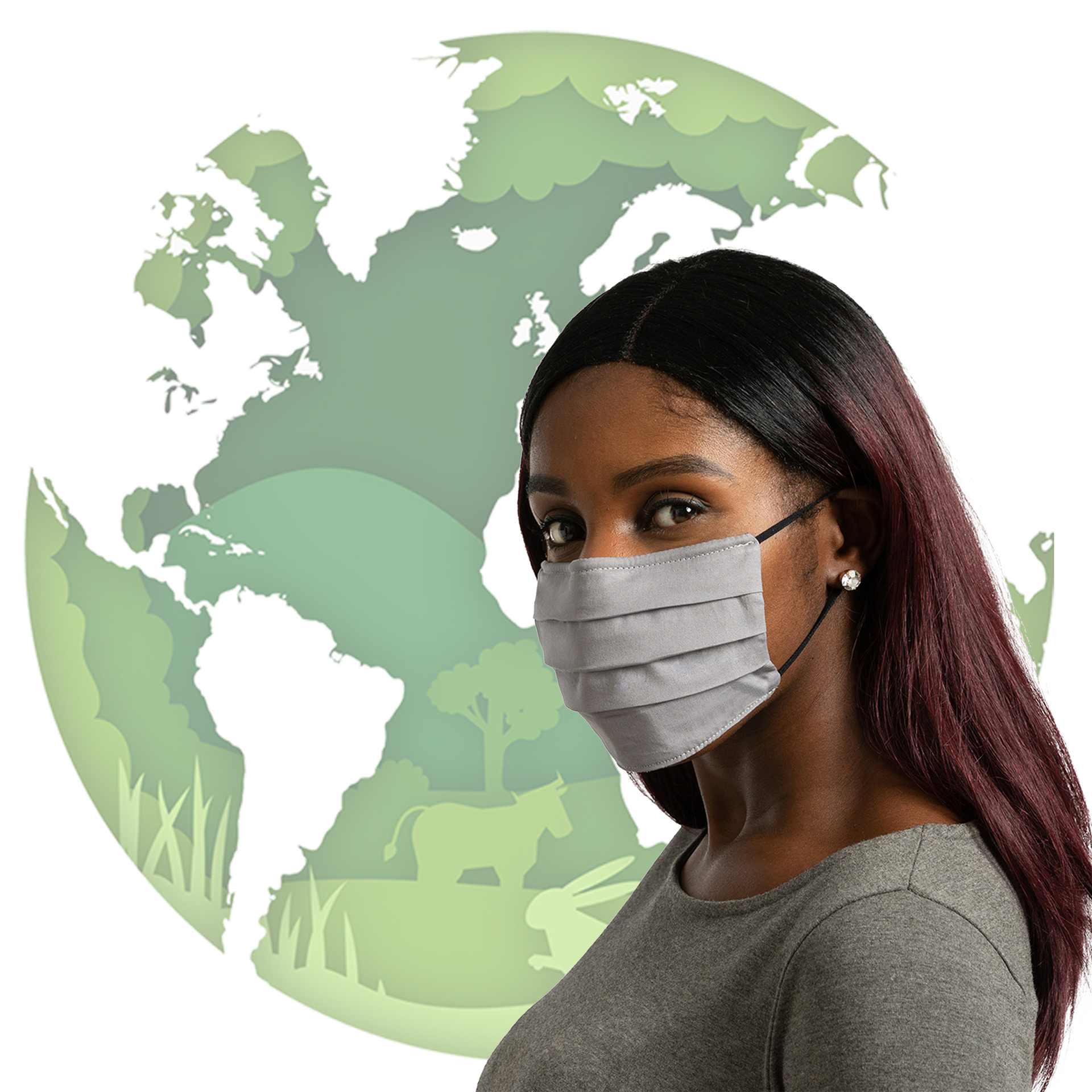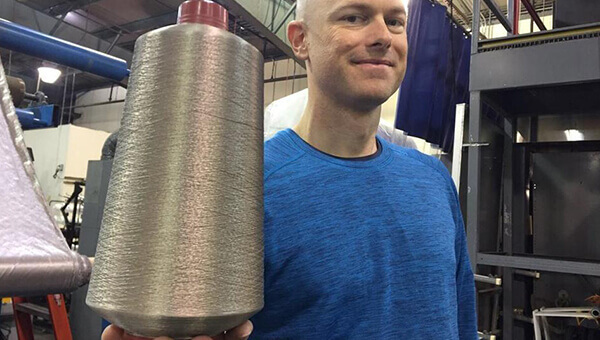


Face masks, for better or worse, have become synonymous with the Covid-19 health pandemic that has affected the global population. In the UK alone, there have been over 4 million reported cases and over 100,000 deaths attributed to Covid-19.i While the science supports the use of face masks in being a first step to reduce the chances of transmitting and contracting Human Coronavirus, the environmental burden of face masks are often overlooked.
Disposable face masks: rivalling the plastic bag?
The main culprit more often than not is the humble disposable face mask. The sheer volume of them is absolutely staggering. It has been estimated that 194 billion disposable face masks and gloves are being used every month worldwide.ii In the UK, the number of disposable face masks that will be used across the UK in 2021 has been calculated at 19.5 billioniii, with 53 million masks ending up in landfill every day in the UK.iv It would be fair to say that single-use face masks are fast rivalling the plastic carrier bag as a major symbol of plastic waste.
Single use disposable masks are by nature intended to only be used once and then discarded. This does not sit well with the environmental 3Rs of Reduce, Reuse and Recycle. In addition, the majority of disposable face masks, both the surgical and the respirator variety, are typically made from plastic polymers. The potential for widespread terrestrial and aquatic pollution is already being seen around the world in direct contrast to concerted global calls to action to reduce our plastic waste.
In waterways and oceans, disposable single use masks could take up to 450 years to fully break down.v Not only are their immediate concerns for wildlife that get tangled up in discarded face masks, there are even more pressing concerns over microplastic (plastic fragments with dimension of <5 mm) pollution.
What is microplastic pollution? Marine animals mistakenly feed on the microplastics, ingesting the plastic waste. Chemicals in the plastic accumulate in animal tissues and increase in concentration – bioaccumulate – as the pollutants are transferred up the food chain, including to humans. Besides the associated chemical loads, ingested plastic materials can be damaging for marine organisms, as they can lead to digestive blockage or internal damage from abrasion.vi
Recent studies have investigated whether disposable masks could be a source of microplastic pollutants in the environment. Results strongly suggest that these masks do act as a potential source of microfibers when they are released into the environment, adding additional burden to current microplastic pollution.vii
This isn’t even touching on the potential biohazard risk that discarded face masks pose to wildlife and people coming into contact with potentially contaminated masks. Despite millions of people being told to use face masks, little guidance has been given on how to actually dispose of or recycle them safely. Even disposing of face masks that have been properly thrown away poses a number of environmental problems. The majority of PPE, including surgical and respirator masks, cannot be readily recycled because it is classified as medical waste. This means the main disposal routes are landfill or incineration, both of which have negative environmental consequences; incineration releases carbon dioxide and other toxic gases into the atmosphere, while landfills can leak pollutants into groundwater.
As countries roll out vaccination programmes, begin to lift lockdown restrictions, and impose new face covering requirements, the use of face masks looks like it is set to remain the norm in the coming few months and beyond. Without a clearer understanding of environmental impacts of disposable masks an environmental time bomb is looming. What is crystal clear is that our current consumption of disposable masks is not sustainable.
What can be done about it?
While the need for face masks is unlikely to diminish in the near future, there are a number of aspects to consider when purchasing and using a face mask for everyday use. This does not take away from the fact that medical grade masks are still essential part of the PPE toolkit in the healthcare environment.
The most obvious choice is to plump for a reusable mask, but it should be remembered that not all reusable masks are made equal:
- Layers: According to the World Health Organization (WHO), the ideal reusable mask can be rewashed multiple times and have a combination of three distinctive layers, providing 2-5 times increased filtration efficiency compared to a single layer of the same cloth.viii The higher the filtration efficiency, the more effective a mask is a filtering out particles
- Washing: it has been found that hand washing masks increases the environmental impact as while machine washing consumes electricity; hand washing consumes more water and detergent for each mask.ix Make sure you wash your face masks regularly and follow washing instructions for the fabric
- Longevity: make sure that you look at the life expectancy of your face mask, as they will begin to lose their integrity and filtering properties they more they are washed. Some manufacturers give an indication of how long a reusable mask should last, including wash tests and how many washes they recommend. But you should replace your reusable face mask if the fit is no longer snug against your face, if the material becomes see through when held up to the light, you are repeatedly adjusting the mask and touching it or if there are rips and tears in it. The less layers in a mask or a poorly constructed mask will have a shorter life span and will need replacing more frequently
- Filters: you should choose masks that have filter in them wisely. Masks that have pouches to insert and use disposable filters generally have a higher environmental impact because the filters are often made from plastic similar to disposable masks, and recommend that the filter be discarded and replaced regularly, if not after every use. This poses similar environmental concerns with disposing of single-use masks and microplastic pollution. You should try and chose a reusable mask that has a filter layer but one which can be washed and reused
- Composition: some reusable masks offer additional safety features such as antimicrobial protection properties. Make sure you do your research into this properly. Antimicrobial coatings or sprays are applied to face masks but will wash out after a number of washes losing their antimicrobial efficacy, which means they will need replacing. This also means chemicals from these applications enter waterways posing chemical pollution threats. Ensure that reusable mask you buy has longevity and the properties you like stay enact for the entire life of the face mask
- Extra masks available: Try to carry a spare reusable face mask so if something goes wrong with the one you are currently wearing you won’t need to use or buy a disposable mask
- Locally manufactured: to reduce the air miles associated with transporting products including face masks, you should also consider buying locally manufactured masks
And if you do find yourself in a position of having to wear a disposable mask then ensure you dispose of it properly in a bin. Do not place your disposable masks in recycling as they can get caught in equipment and be a potential biohazard to waste workers. To avoid an potential entanglement by wildlife make sure you also cut the ear straps on a disposable mask before you dispose of it. And above everything else, do not litter!
Is there a holy grail for face masks? Can face masks ever be truly sustainable?
While we all strive to be more sustainable in our lives, choosing a face mask to wear that will keep you both safe and which is environmentally friendly isn’t straightforward. It is clear that disposable face masks have a huge environmental footprint from manufacture right the way through to disposal, and the true environmental impact has yet to be fully realised. There are alternatives to disposal of masks being developed which include pyrolysis, which uses heat to break down plastic in a deoxygenated environment, turning it into a liquid oil that can then be burned for energy. While this is potentially an alternative to landfill or incineration, it isn’t the ultimate goal of being able to recycle and reuse the materials indefinitely. The option to recycle used disposable masks is also an option being touted but the reality is far from clear. Contamination issues are perhaps the main source of concern, and the fact that a dedicated specialist recycling partner is needed, as this is not an option being offering by local councils.
A plastic-free future does seem that little bit further away but it isn’t out of reach. Unless you are required to wear a medical grade disposable mask, the best environmentally friendly option is to get a reusable face mask that can be worn, washed and reused. When choosing a reusable face mask, make sure you select a face mask that not only keeps you safe but also has environmental attributes to reduce your individual environmental impact. We can all do our part to help the environment by one small action at a time.
------------------------------
[i] Official UK Government website for data and insights on Coronavirus (COVID-19) https://coronavirus.data.gov.uk/details/cases,and https://coronavirus.data.gov.uk/details/deaths, accessed 17th February 2021
[ii] Environ. Sci. Technol. 2020, 54, 13, 7760–7765. https://doi.org/10.1021/acs.est.0c02178, 12 June 2020
[iii] https://www.twinfm.com/article/face-mask-disposal-still-a-high-concern#:~:text=Increased%20Single%20Use%20Impact,rivers%20and%20eventually%20the%20sea. and https://www.lifestyledaily.co.uk/article/2021/01/25/dumped-contaminated-face-masks-blight-uk-causing-health-safety-nightmare
[iv] https://environmentjournal.online/articles/the-environmental-impact-of-abandoned-face-masks/
[v] Waste Free Oceans, www.wastefreeoceans.org/post/plastic-masks-take-450-years-to-decompose-in-nature
[vi] www.treehugger.com/what-are-microplastics-1204133
[vii] www.ncbi.nlm.nih.gov/pmc/articles/PMC7574683/, Fadare and Okoffo, 2020, Covid-19 face masks: a potential source of microplastic fibers in the environment. Sci. Total Environ. 2020;737 www.ncbi.nlm.nih.gov/pmc/articles/PMC7297173/; Aragaw, 2020, Surgical face masks as a potential source for microplastic pollution in the COVID-19 scenario. Mar. Pollut. Bull. 2020:111517. www.ncbi.nlm.nih.gov/pmc/articles/PMC7381927/
[viii] WHO, www.who.int/emergencies/diseases/novel-coronavirus-2019/advice-for-public/when-and-how-to-use-masks
[ix] https://theconversation.com/coronavirus-face-masks-an-environmental-disaster-that-might-last-generations-144328



